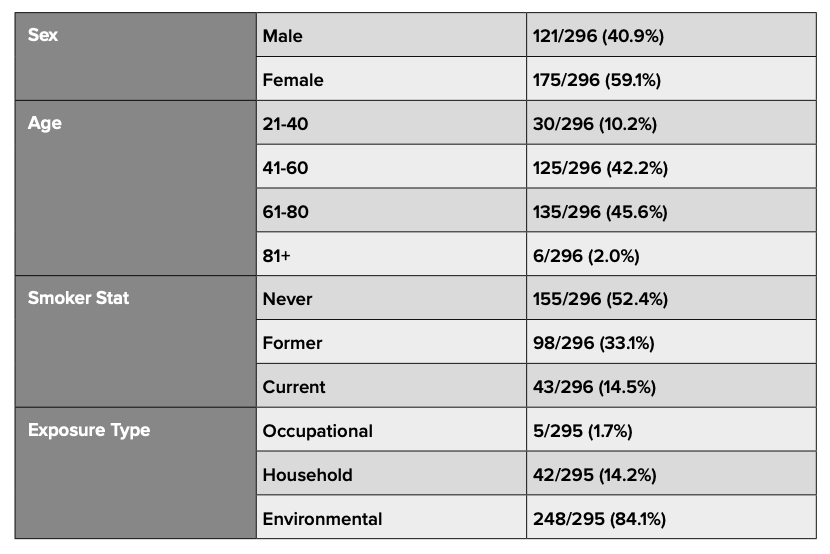Aiden Niblett, Jean Pfau, and Kinta Serve focus on asbestos-induced autoantibodies across different demographics in Libby. They emphasize the importance of understanding the impact of asbestos
The history of asbestos in Libby Montana
Asbestos is a naturally occurring fibrous silicate mineral that has been used in construction due to its tensile strength and heat resistance. However, its small size and rigid shape allow it to enter deep into the respiratory tract upon inhalation, and exposures have been linked to serious lung diseases like pulmonary fibrosis and cancers. (1)
The town of Libby, Montana, has a history of asbestos exposure due to a local vermiculite mine that operated from 1920-1990. Vermiculite mined from Libby and sold in products such as Zonolite Attic Insulation was found to be contaminated with Libby Amphibole (LA) asbestos, a unique mix of tremolite, winchite, and richterite fibers that is associated with severe lung diseases. (2)
Town and mine site cleanup actions by the U.S. Environmental Protection Agency began in 2000 and proceeded until 2018. (3) However, prior to 2018, all residents of Libby and immediate surrounding areas were considered to have been exposed to LA asbestos, placing this population at a higher-than-average risk for developing asbestos-related diseases.
Libby and autoimmune disease
Researchers studying the Libby population through the early 2000s noted an unusually high incidence of systemic autoimmune diseases, including lupus and rheumatoid arthritis. (4, 5) Follow-up studies noted a particularly high prevalence of mesothelial cell autoantibodies (MCAA) among people with pleural disease. (6, 7) A similar correlation was later noted between anti-plasminogen (anti-PLG) antibodies and lamellar pleural thickening (LPT, a type of fibrosis). (8)
LPT is a debilitating disorder that makes deep inhalations difficult and painful, thus limiting most physical activity. Researchers at Idaho State University, Montana State University, and the Center for Asbestos Related Diseases (CARD) in Libby have been collaborating to better understand the prevalence of asbestos-induced autoantibodies among different demographic groups and to identify mechanisms by which autoantibodies drive pleural disease. (9)

Figure 1. Male subjects exhibited a trend representing higher anti-PLG and anti-MCAA prevalence compared to female subjects.
Considering demographics
Most subjects included in early studies in Libby were exposed occupationally in the vermiculite mine or processing plants. This means that most study participants were male, older, and had relatively high fiber exposures. Our current study expands this population to include people who were environmentally exposed to LA due to residing in or near Libby. Consequently, it includes people of various ages and more females than in occupational studies.
Looking at multiple demographic variables creates an opportunity to identify any subpopulations particularly vulnerable to asbestos-associated autoimmunity, since autoimmune disease may present differently across groups. For example, in the general population, 80% of people diagnosed with autoimmune conditions are women, thus highlighting the importance of including diverse populations in participant pools. (10)
Participants for this current study were self-selected adults who lived in Libby for at least six months, at least ten years ago. While this study is ongoing, we have analyzed data from approximately 300 subjects to identify the prevalence of MCAA and anti-PLG antibodies among various groups, including biologic sex, age, smoker status, and LA exposure type (i.e., occupational vs. environmental). Table 1 provides the demographics of participants screened to date.
Antibody levels across demographics
Participants’ serum samples were screened for MCAA and anti-PLG. They were considered positive for an antibody if the antibody levels were more than three standard deviations above the average of unexposed, control individuals. (6) Overall, approximately 15% of the population was positive for MCAA and 14% positive for anti-PLG.
We hypothesized that women, smokers, or occupationally exposed individuals would present with higher autoantibody levels compared to men, non-smokers, and environmentally exposed individuals. While interesting trends have emerged, no statistically significant differences in autoantibody prevalence have been noted among the demographic groups examined alone or in combination.
The trend of most interest was that males have a higher rate of positive status for both MCAA and anti-PLG (Figure 1). This is particularly interesting as autoimmune conditions are generally more common in women than men. (10, 11) Additional studies are needed to clarify the interaction of biological sex and fiber exposure on autoimmunity.
Additionally, autoantibody frequency is similar regardless of exposure type, age, or smoker status. When considering exposure type, we expected that as the dosage of asbestos exposure decreased from occupational, to household, to environmental exposures, so would autoantibody levels. The fact that no significant differences were found in autoantibody levels between these exposure types suggests that the autoimmune response induced by LA asbestos may be just as common at lower-dose environmental exposures as in higher-dose occupational exposures. Thus, asbestos-induced autoimmunity may not occur in a dose-dependent manner and may not be influenced by additional factors such as age.
Future directions
The data from this study will continue to be used in conjunction with other data, including CT scans, chest X-rays, and systemic autoimmune diagnoses made by clinicians, to understand the risk of disease development in LA-exposed people. Patients will continue to be monitored by CARD staff to determine if any autoimmune markers may be useful predictors of future disease development or progression.
Funded by ATSDR screening grant 5 NU61TS000295-05-00
Sources
- Pfau J.C., et al. 2014. https://doi.org/10.1155/2014/782045
- Black, B., et al. 2014. https://doi.org/10.1002/ajim.22330
- Environmental Protection Agency. 2017. https://cumulis.epa.gov/supercpad/SiteProfiles/index.cfm?fuseaction=second.cleanup&id=0801744#:~:text=Gold%20miners%20discovered%20%20vermiculite%20in,bought%20the%20Zonolite%20%20mining%20operations
- Pfau, J.C., et al. 2005. https://doi.org/10.1289/ehp.7431
- Noonan, C.W., et al. 2006. https://doi.org/10.1289/ehp.9203
- Marchand L.S., et al. 2012. https://doi.org/10.1016/j.toxlet.2011.10.024
- Gilmer, J., et al. 2016. https://doi.org/10.1152/ajplung.00462.2015
- Pfau, J.C., et al. 2019. https://doi.org/10.1080/08958378.2019.1699616
- Pfau, J.C. 2023. https://doi.org/10.33548/SCIENTIA921
- Angum, F., et al. 2020. https://doi.org/10.7759/cureus.8094
- American College of Rheumatology. 2023. https://rheumatology.org/patient-blog/differences-between-the-sexes-in-rheumatic-disease

This work is licensed under Creative Commons Attribution-NonCommercial-NoDerivatives 4.0 International.


